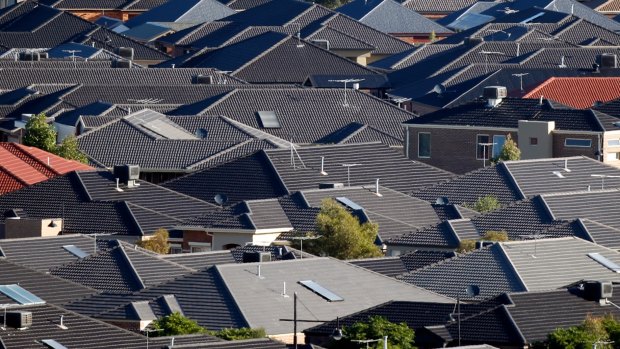This was published 5 years ago
Opinion
Will we never learn? Urban sprawl is not the answer
By Nicola Philp
Back in the late 19th century, Melbourne went through a massive land boom. As the population of the city was skyrocketing, so too was the demand for a place to live. Land prices rose along with demand and swaths of what were orchards and market gardens began to be subsumed in this frenzy.
Mortgage brokers, banks and land banks were encouraging what we would now call "mum and dad investors" to speculate on land. Sound familiar? They were sold the suburban lifestyle and so places such as Hawthorn, Essendon, Box Hill and Heidelberg were born. What followed was the inevitable crash and subsequent depression, which the city took decades to recover from.

With some of these suburbs over 60km from the city, at what point do we cease to call something part of the capital?Credit: Paul Rovere
Fast forward to 2019 and we see that more bands of land on the outskirts of Melbourne are going to be rezoned for housing, with the similar purpose of offering people "The Dream".
The telling difference between the 1880s and 2019 is that when speculators went to inspect potential land over a century ago, they did so often by taking a free train trip because the transport was already there. (They even got chicken and champagne lunches!) This is because railway lines (both state and private) servicing agricultural, forestry and manufacturing industries were already installed through these sprouting inner suburbs, with stations open at Malvern, Oakleigh, Mentone and Caulfield, to name a few.
Potential buyers in the 21st century will have a hard time locating these new land sites, even with the help of a car and Google Maps. There’s a V/Line train vaguely nearby, but let’s hope new residents don’t expect it to improve, as railways are only at the planning for planning stage.
With some of these suburbs over 60 kilometres from the city, at what point do we cease to call something part of the capital? What these new settlers are really buying is more time and money in a car, less access to essential services and the promise of one day, maybe, getting some public transport, sort of.
The infrastructure needs to be the priority build – railway lines are much easier to install before people are bustling about. Get businesses established, schools ready, trees planted, hospitals built and then open up land packages.
As I take the train from Geelong to Melbourne, I reflect on the housing sprawl that will one day merge the boundaries between the two. What I see is a dusty, barren dream turned commuting nightmare. There are few trees, no schools, no stations, no soul. Houses are massive in both size and, one imagines, mortgage, and people have no time to interact with each other because they are too busy working and commuting to pay for it all.
A friend of mine lived in one such estate out in South Morang, building a dream home and hoping for a beautiful new life. What became reality was the silence. She spent hours commuting to her job in the city and then, as a new mother, walking deserted streets and talking to herself. There were no cafes, no meeting places, minimal buses and very few ways to get a sense of community. They sold up and moved.
What we actually need to do is look at ending the sprawl and managing growth efficiently, especially with Melbourne to overtake Sydney’s population within a decade. Continual oozing at the city borders is not helpful to anyone, least of all the people who are sold the idea of owning their own home.
Nicola Philp is a regular contributor.